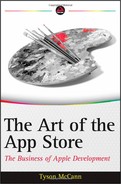5
Plotting the Stages of Development
- Understanding traits of successful leadership
- Understanding roles and responsibilities of those on your team
- Starting with a “controlling idea” or vision for your app
- Making the best of agile development
- Using scheduling techniques aimed at reducing risk
- Discovering outsourcing, localization, and communication tips
- Understanding all stages of development
- Discovering marketing tips for a successful launch
Development of a new app can be a daunting task, particularly for the uninitiated. At its root is typically fear — of failure, of success, of cost overruns, of the unknown. As correctly spelled out in many motivational books, the only way to master fear is to take action — in this case, by putting aside any misgivings and getting to work. Mistakes are inevitable during application development, but to best mitigate them, you should rely on a fairly systematic process of iteration and agile development throughout. Such a process is spelled out in this chapter, with suggested reading noted in the (unlikely) chance that you are left wanting more information.
Before diving into the details of this chapter, you should be aware of the creative process. Working with new platforms such as multitouch iOS devices has a very “Wild West” sort of feel to it — exciting, new, and lawless. With relatively very little history behind touch devices, opportunities for new user interface (UI) design and ways to interact still abound. Unlike desktop or even web applications, there are few “rules,” and even those can be bent or broken. But just as the potential for innovation and/or success is monumental, the risk of failure (or, perhaps worse, a brief swim in mediocrity) also looms quite large in the App Store market.
So, on one hand, to offer the best chance at success, new apps must innovate on at least one level. And, on the other hand, innovation is no good without a process of delivery. If you've ever wondered how you can manage to innovate while adhering to processes, you're not alone; entire books are devoted to the conundrum.
Therefore, this chapter examines techniques designed to enhance app innovation by directing your thinking to the right places before even a single dialog box is created. While multitouch design is relatively new, creating software, fortunately, is not. Learning from the mistakes and failures of competitors, as well as a smart approach to innovation, will help bring to the masses new experiences worth sharing through your new iOS app.
![]() For more information on adhering to processes while being innovative see The Creative Habit: Learn It and Use It for Life by Twyla Tharp (New York: Simon & Shuster, 2005), The Design of Everyday Things by Donald A. Norman (New York: Basic Books, 2002), and The Design of Design: Essays from a Computer Scientist by Frederick P. Brooks, Jr. (Boston: Addison-Wesley, 2010).
For more information on adhering to processes while being innovative see The Creative Habit: Learn It and Use It for Life by Twyla Tharp (New York: Simon & Shuster, 2005), The Design of Everyday Things by Donald A. Norman (New York: Basic Books, 2002), and The Design of Design: Essays from a Computer Scientist by Frederick P. Brooks, Jr. (Boston: Addison-Wesley, 2010).
Let's start by examining some tips for laying a foundation to properly build a solid team through leadership, information about team roles, and why you should start with a written vision for your app.
